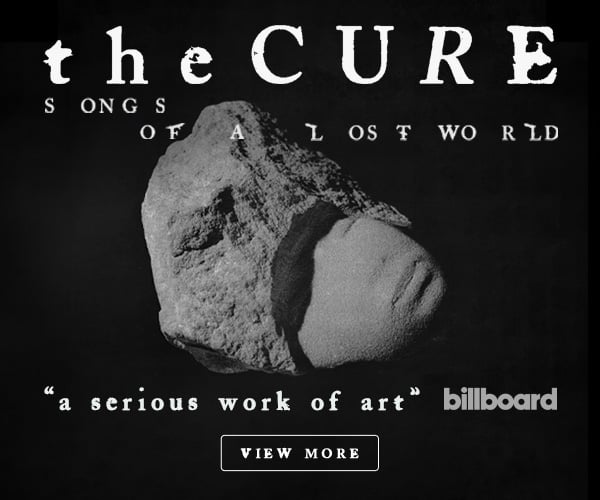Beggars Group boss Martin Mills delivered an impassioned speech in London this morning, expressing his fears over the “forces wishing to destroy a diverse music climate”.
Speaking at the launch of the new Manifesto from the Entertainment Retailers Association (ERA), Mills articulated his serious concerns over recent adjustments to Billboard‘s albums chart in the US.
Single track streams and downloads are effectively now being added up to equate to ‘albums’ on the Billboard 200 – with 10 digital sales or 1,500 streams, of any track from an LP being counted as one whole album.
In a speech that you can read in full below, Mills castigated a chart that risks “reducing the oxygen available for exposure for artists whose natural format is the album” while serving the “interests of super-consolidated major labels”.
Mills suggested that today’s music market has returned to a landscape reminiscent of the pre-punk years, when there was a clear division between ‘album artists’ and ‘singles artists’ . He commented that mixing single-track streams into the albums chart could see 2015’s most innovative musical performers sidelined even further.
He omitted any mention of the UK’s new Official Albums Chart. The territory’s Official Charts Company has also folded in streaming into the rankings, but uses a more complex weighting formula than Billboard’s – one it says has been designed to protect the ‘integrity’ of the album.
Mills also had some cross words for for the IFPI‘s proposed Global Release Date; or, more particularly, its decision to press ahead with the decision to issue all new physical releases on a Friday around the world.
“I acknowledge the needs of a digital world for co-ordination, it seems to me to be crazy to throw away one of the trading week’s two peaks, and the ability to re-stock and rectify errors before the week’s second peak,” he said.
“It astounds me that the major labels are not listening to their customers, their interface with their artists’ fans. I fear their consultation has been a charade, and the market leaders were always going to push this through.”
MBW has divided Mills’s full speech – delivered in front of a room of 110 retailers this morning – into its main themes below.
Martin Mills on streaming, release dates and the important of retail
I’m particularly happy to be here today because my roots are in retail. This beard was grown in the fortnight that we hand shop-fitted the first beggars banquet shop in earl’s court.
My continuing belief in retail is now manifested in our involvement in the rough trade stores, now seven strong and growing, here and abroad. Our new Nottingham store is I believe the exemplar of what independent music retailing can be in this era.
I equally believe in digital retail. All the fashionable verbiage in the first dotcom decade about disintermediation and d2c always struck me as ignoring the fundamental skills of retailing. Retail is the interface between artist and fan through their recorded music, and every time I see attempts to cut out the retailer fail, I am surer and surer of that.
Certainly, direct to fan has a key place, but it’s a tiny part of the market. Retail, and retail skills, is the connector.
Rather than disintermediation, the internet brought disaggregation, the single biggest change in this era. And that has identified two tribes of consumers, and two tribes of artist – those that want their music in album form, and those that want it in track form. Over the decades there have been times when the album and singles charts have converged, and times when they have diverged. When beggars banquet first had stores, we didn’t even sell singles, the two formats represented music at opposite poles.
Did anyone here buy a Mud album, or a Jackson Browne single ?
Punk changed that, and over the next few decades albums and singles largely overlapped. That has changed back again now, and the singles and albums charts now represent, other than for superstar artists, two different worlds.
Singles vs albums – and the ‘lowest common denominator musical landscape’
I must admit to having been surprised that the disaggregation that Steve Jobs gave us didn’t destroy the album. I didn’t expect it to survive in the digital format as well as it has.
In my personal listening habits at the time, I moved from albums to playlists of my favourite songs. But soon it felt like having ice cream for every meal, and I went back to the album, having missed the less obvious songs, those it takes longer to love, and the breadth of insight into an artist that the album allows.
And many artists too, in the face of track temptation, have been resolutely committed to the album format, as their preferred format of artistic expression. So now we have artists that live in the singles world, and those that live in the albums world.
Generally speaking, independent labels work principally with album artists, the majors, since their main marketing tool is airplay, primarily with artists capable of having hit singles. I’ll acknowledge this is a huge generalisation, but I believe, fundamentally, that today it holds true. The biggest artists of course straddle both worlds.
This can be seen most clearly in comparing an artist’s track sales to their album sales. An artist like The National will sell pretty much 1:1 tracks to albums, a pop artist maybe 15:1. That’s an enormous differential in customer purchase preferences.
I think this two-sided world is healthy, good for music, good for the consumer. It creates a diverse musical climate, because not all artists are running the same race.
But I am really concerned that there are forces at work that wish to destroy this, to create a lowest common denominator musical landscape.
In the USA it’s already started to happen, with the Billboard consumption chart, that combines album sales, streams, and track sales. In other words, it aggregates and averages out the two types of artist I’ve identified.
That will mean that the big artists look and get bigger, and the more niche artists of the album world get swamped, and side-lined, starved of exposure.
‘This will inevitably curtail the ability of the non-pop-single artist to make a living from their art’
I have no objection to including streams in the chart, as long as – and it’s a big but – fans that are streaming albums as a whole are separately identified. So the albums chart should include album streams, and the singles chart should include track streams.
But including tracks with albums mixes apples with pears, and fails to chart anything meaningful other than sheer brute size.
It may well be in the interests of the small number of super-consolidated major labels to make the big become bigger, and appear to be even bigger; but I believe it’s fundamentally against the interests of the rest of us, since it will reduce the oxygen available for exposure for artists whose natural format is the album.
That reduction in exposure will, I believe, lead inevitably to the decline of the album, and a curtailing of the ability of the non-pop-single artist to make a living from their art.
That will hurt all labels and artists long term, I believe, as lack of diversity will strangle innovation and music will become moribund and uninteresting, and consumer interest will erode. It will also disempower the artist since the major labels will regain total control of access to market.
It will create short-termism, and damage career longevity. After all that has been achieved in the last few decades in terms of artists’ control over their careers, it would be tragic if that were to be reversed by this tide.
And of course, for you physical retailers, that spells the beginning of the end for you, since you hardly sell tracks, and for you digital retailers, it probably means that a new fan is consuming a track rather than an album, which is not great for you either.
Global Release Day: ‘The consultation has been a charade’
I have similar concerns about the proposed Global Release Day. Whilst I acknowledge the needs of a digital world for co-ordination, it seems to me to be crazy to throw away one of the trading week’s two peaks, and the ability to re-stock and rectify errors before the week’s second peak.
It astounds me that the major labels are not listening to their customers, their interface with their artists’ fans. I fear their consultation has been a charade, and the market leaders were always going to push this through.
I fear this move will also lead to a market in which the mainstream dominates, and the niche, which can be tomorrow’s mainstream, is further marginalised. I fear it will further cement the dominance of the few – and that that is exactly what it is intended to do.
Digital is vital – but industry can’t put short-term profits ahead of our future
We love the growth of digital retail. It has changed our musical world for the better. But no parts of this industry should be digging the grave of physical.
Physical is not dying, it’s mutating, and that applies to retail in general, not just to music. The tide that is flowing in the direction of online and mass market retailing is being counteracted by another tide which seeks localness, service, choice, product knowledge.
We should heed the lessons of Norway, which went full steam for digital and is now lamenting the physical it’s lost, and Germany, which never let go of physical, and is now stronger than ever.
And whilst we love our digital worldwide mega-players, it’s important that our major suppliers, and all of us, encourage the growth of local, niche, or specialist digital services, as flourish in the physical world.
That may mean, for them, less onerous upfront terms. Disproportionate advances, guarantees, and breakage, have distorted our industry, reduced transparency, created suspicion, limited funds available for marketing and promotion, and hobbled new services. I believe the market would be healthier for everyone without them.
On the retail side – let’s not allow our new digital giants, and the brave new world of data and algorithims, blind us to the fact that the greatest music almost always starts off in the underground, comes from left-field.
Measuring what fans want to hear, and leading them further down that path, is one thing – finding what they don’t know they want yet is quite another, and THAT is the lifeblood of our industry.
There must be room for the small to grow, alongside the large – in the interests of the large, as well as the small.
In an era of unimaginable change and transition for our industry, the new industry needs nurturing. Whereas we must certainly all protect and enhance the value and integrity of our rights, those rights which, hopefully, allow our artists to survive, now is not the time for the major players in our world to maximise short term profits at the cost of our futures.
Now is the time to allow those that wish to invest in our future to do so as efficiently as possible.Music Business Worldwide





